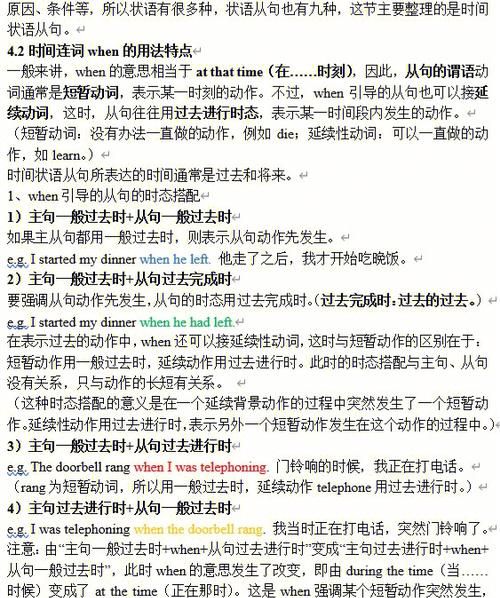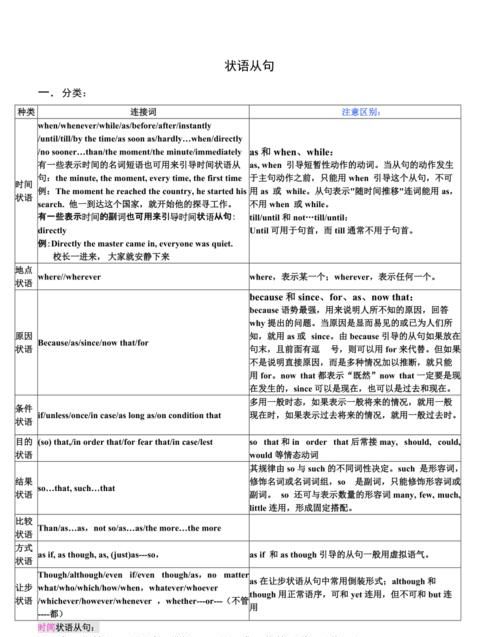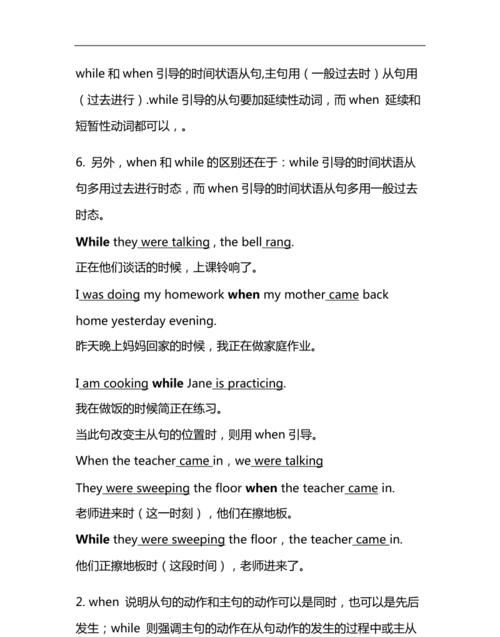本文目录
所有时间状语
一、时间状语从句:主要由when,whenever,after,before,as,(ever)since,once,as soon as,(not)until,while等连词引导
1) ,Alexander Graham Bell was still a young man.
〔A〕 He invented the telephone
〔B〕 The telephone was invented
〔C〕 His invention of the telephone
〔D〕 When he invented the telephone
2) The small greenish flowers of the American elm tree appear in the spring, .
〔A〕 is grown long before the leaves
〔B〕 long before the leaves grow
〔C〕 the leaves before growing long
〔D〕 the growth of leaves before long is
3) _,heat is produced.
〔A〕The mixing together of certain chemicals
〔B〕Whenever certain chemicals are mixed together
〔C〕Certain chemicals mixed together
〔D〕 That certain chemicals are mixed together
二、结果状语从句:考试中主要集中在“so…that”(这样……以致) 引导的状语从句,除此之外,还有“such…that”等其他连接词可以引导
4) Lucretia Mott’s influence was too significant 〔A〕 that she has been credited 〔B〕 by some authorities 〔C〕 as the originator 〔D〕 of feminism is the United States.
5) Dorothy Parker’s satirical 〔A〕 verse was quite 〔B〕 popular that her books of poetry 〔C〕 appeared 〔D〕 on best�seller lists.
三、让步状语从句: 让步状语从句通常由(even)though,although,no matter,even if ,however,whatever等词引导
6) Hippopotamuses, a great deal of time submerged in lakes or rivers,do not feed in the water.
〔A〕 spend
〔B〕 they spend
〔C〕 although they spend
〔D〕 which they spend
7) do not have webbed feet, gallinules are excellent swimmers.
〔A〕 They
〔B〕 Even though they
〔C〕 That they
〔D〕 It is when they
四、原因状语从句: 原因状语从句可由as,because,since及for引导,而托福考题集中在由“because”引导的从句
8) Nelon is said to be inert does not react easily with other substances.
〔A〕 becaues of it
〔B〕 because it
〔C〕 it is because
〔D〕 is because it
9) Helium is safer than hydrogen it can not explode.
〔A〕 while
〔B〕 though
〔C〕 because
〔D〕 if
五、条件状语从句: 表条件的状语从句主要由if,whether,as long as (只要),provided(只要) (that)等词引导,例如
10) Uniform acceleration occurs the rate of change remains the same over successive equal intervals of time.
〔A〕 according
〔B〕 if
〔C〕 with
〔D〕 under
11) Abstraction goes into the making of any work of art, or not.
〔A〕 whether the artist being aware of it
〔B〕 the artist is being aware whether
〔C〕 whether the artist is aware of it
〔D〕 the artist is aware whether
六、表示其他关系的状语从句,主要包括地点和行为方式状语从句
12) the Atlantic Ocean crosses the equator,the trade winds cause a flow of water to the west.
〔A〕 Where
〔B〕 And
〔C〕 That
〔D〕 At
13) Nails protect the ends of human fingers and toes protect the toes of most other vertebrates.
〔A〕 claws
〔B〕 as claws
〔C〕 as claws do
〔D〕 so do claws
七、状语从句中的“主语+be”的省略:状语从句中的主语和系动词be常有同时被省略掉的现象,但需有两个前提条件
(1) 从句主语与主句主语一致,且从句谓语为“be”;
(2) 省略后的结构为“连词+现在分词”、“连词+过去分词结构”以及“连词+介词短语”和“连词+形容词(名词短语) ”结构,例
14) ,glasses can correct most sight defects in healthy eyes.
〔A〕 When well fitted
〔B〕 Well fitted when
〔C〕 Well fitted if
〔D〕 If well fitted when
15) Although rigid,bones exhibit a degree of elasticity that enables the skeleton to withstand considerable impact.
〔A〕 apparently
〔B〕 are apparently
〔C〕 apparently their
〔D〕 are they apparently
16) When in arctic regions,the Aleuts construct igloos as temporary winter shelters.
〔A〕 travel
〔B〕 to travel
〔C〕 traveling them
〔D〕 traveling
八、例题解析
1) D无论在语法上还是语意上均正确,而若选A和B,则只是两个句子的无谓罗列,这在英语中是绝对不允许的,而C是一个名词短语,也不符合要求。
2) B对。本句是由连词before引导的时间状语从句,其中的long是副词,修饰before,“long before”意为“早在…之前”,long before易与before long相混淆,before long相当于介词短语,意思是“不久”。
3) B 对。由于逗号后面是一个完整的句子,则本句空白处成分可能是介词短语、分词短语或状语及状语从句,在备选答案中,只有B 具备状语从句的条件。whenever是when的强调式表示“无论什么时候”。
4) A错。本句含“so…that”句型,“so”是副词,它后面可接形容词或副词,而“that”后要接表结果的状语从句,故应将“too”改为“so”。
5) B错。改为“so”。
6) C对。本句主语为“Hippopotamuses”,谓语是“do not feed”,逗号之间显然为插入成分,A和B不符合要求,D虽表面上是非限定定语从句修饰前面的成分,但which指主语,马上又接主语they,成了“双主语”,故应排除。C是由连词although(尽管) 引导的让步状语从句作插入语,完全符合条件,故应选C。
7) B对。逗号后为一完整的句子,逗号前又出现了谓语,那么空白处一定缺起引导从句作用的连词和从句主语,B 完全符合条件,though的用法和although基本相同,意思也相同。C 好像是“that”引导的主语从句,可后面接的并不是谓语,而是一个句子,故C 也不对。D 貌似“it is…that”强调句,但句中缺that,且语法语意混乱。
8) B对。A不对,因为“because of ”(因为) 是成语介词,后面不可接句子,而C和D均不合语法,只有B正确,“it”指代“neon”。
9) C对。本题中的四个选项都是连接词,即都可以引导后面的从句,从语法来说,它们都正确,但从语意及逻辑上看,显然以“〔C〕 because”(表“原因”) 切合题意。
10) B对。本句缺能引导一个从句的连接词,只有B符合条件。
11) C对。whether作为连词,只能放在从句句首,故B 和D 都不符合语法。虽然A中的whether放置于句首,但A 不是一个句子,因此只有C 中的whether才引导了一个状语从句,“whether…or not”在此处表示“无论…”。
12) A对。“where”引导的是地点状语从句,表示“在大西洋通过赤道的地方”。
13) B对。“as claws protect…”表示“正如爪或钳保护…一样”,as引导的是方式状语从句。A 明显不对。C 多“do”,D 好像是“so”引导的倒装句,但“so”不仅无所指代,因为后面不缺任何成分,而且在用“so”倒装句时,“so”前面通常有逗号,并且是“so+助动词(或情态动词等) +主语”结构。
14) A对。从句部分说完整为“When they (glasses) are well fitted”,其中的“they are”被省略掉了。D 中的“If well fitted”本来也正确,但后面多“when”。
15) A对。although后省略了“they (bones) are”,apparently(明显地)是副词,修饰后面的形容词rigid。D 中的are和they顺序有误,否则也同样正确。
16) D对。本句为“连词+现在分词”结构。

比较状语从句用法总结
下面是我整理的一些关于状语从句用法的 总结 , 希望能帮助大家更好地认识状语从句,提高英语水平。
一、由when, while, as引导的时间状语从句
1. when引导的时间状语从句中的谓语动词可以是延续性动词,也可以是瞬时动词。when有时表示“就在那时”。如:
When she came in, I was doing some housework. (瞬时动词)
When I lived with the Smiths, we used to discuss international issues together. (延续性的动词)
We were about to leave when he came in. (when表示“就在那时”)
2. while引导的时间状语从句中的谓语动词必须是延续性的,并强调主句和从句谓语动词所表示的动作同时发生(或者相对应)。如:
While my wife was reading the newspaper, I was watching TV.
(was reading是延续性的动词,was reading和was watching同时发生)
3. as 引导的时间状语从句中的谓语动词表示延续性的动作,一般用于主句和从句动作同时
发生,有时也可以强调动作一先一后发生。如:
We always sing as we walk.
As we were playing out, it began to snow.
二、由till或until引导的时间状语从句
till和until一般情况下两者可以互换,但是在强调句型中多用until。需要注意的是:如果主句中的谓语动词是瞬时动词时,必须用否定形式;如果主句中的谓语动词是延续性动词时,用肯定或否定形式都可以,但表达的意思不同。如:
Don’t open it till your birthday.
It was not until the meeting was over that he began to teach me English.
Continue in this direction until you see a sign.
I didn’t work until he came back.
三、由since引导的时间状语从句
1. 若since引导的状语从句的谓语动词是终止性的过去时,则从句表示的时间是“从动作开始的那一时刻起”。如:
He has studied very hard since he came to our school.
We have been missing them since they left here.
2. 若since引导的状语从句的谓语动词是持续性动词或表示状态的动词的过去式时,则从
句表示的时间是“从那持续动作或状态结束时算起”。如:
How long is it since you lived in Shanghai?
John is now with his parents in New York. It is already three years since he was a teacher.
四、由as soon as, immediately等引导的时间状语从句
as soon as, immediately, directly, instantly, the moment, the instant, the minute等这些词语均表示“一……就……”。如:
I want to see her the moment she arrives.
I came immediately I heard the news.
注意:hardly (scarcely, rarely) … when / before; no sooner … than也表示“刚……就……”,但是其主句使用过去完成时,从句用一般过去时,而且,当hardly, scarcely, rarely和no sooner位于句首时,主句应用倒装语序。如:
Hardly had we begun our walk when it began to rain.
I had no sooner left than she called.
五、由each time, every time引导的时间状语从句。如:
Each time she moved her head she let out a moan.
六、由by the time引导的时间状语从句
如果从句的谓语动词用一般过去式,主句的谓语动词用过去完成时;如果主句的谓动词用一般现在式,主句的谓语动词用将来完成式。如:
By the time they get here, we’ll have finished the work.
By the time you come here tomorrow, I will have finished this work.
七、由the first time引导的时间状语从句
the first time常引导时间状语从句,其重点不是讲第一次做什么,而是说明另一动作或情况;也可以作表语,强调到说话为止某一情况或动作的次数。如:
I knew we would be good friends the first time I met her.
比较:for the first time表示有生以来或一段时间内第一次做某事,在句中一般单独作状语。如:
The two girl students talked for the first time at the beginning of the term.


时间状语从句讲解视频
一、when“当……时”,引导时间状语从句时,从句用于表示主句动作发生的特定时间.如:
The days get longer when spring comes. = When spring comes, the days get longer.
春天到来时,白天变得更长了.
二、before“在……之前”,引导时间状语从句时,表示主句动作发生在从句动作之前.如:
Close the door before you leave the room.
离开房间前关上门.
三、after“在……之后”,引导时间状语从句时,表示主句的动作发生在从句的动作之后.如:
I went to school after I finished my breakfast.
吃完早饭后我就去上学了.
四、as soon as“一……就……”,引导时间状语从句时,表示主句动作紧接着从句动作发生.如:
I’ll call you as soon as I get home.
我一到家就给你打电话.
五、until, till“直到”,引导时间状语从句.当主句谓语动词是延续性动词时,主句常用肯定形式;当主句谓语动词是非延续性动词时,主句要用否定形式,即“not…until/till…”意为“直到……才……”.如:
I’ll wait here until/till the rain stops.
我将在这里等着,直到雨停.
You can’t go home until/till you finish your work.
直到你完成你的工作,你才能回家.
下面再向大家透露点儿内幕消息,状语从句的两手绝活——时态的呼应和从句的位置.请看:
一、时态呼应
一般来讲,复合句都要遵循主、从句时态呼应规律,状语从句也不例外.即主句用现在时,从句也用现在时;主句用过去时,从句也用过去的某种时态.如:
Be careful when you cross the road.
过马路时要小心.
You must see the doctor if you are ill.
如果你生病了,你必须去看医生.
主句是一般过去时,从句也要用一般过去时.如:
When he was seven years old, he could swim.
当他七岁时就会游泳.
She turned off the light before she left the office.
她离开办公室前就关了灯.
二、主从句的位置.
大多数情况下,从句可以位于主句之前,也可以位于主句之后.不过从句在前时,主从句之间必须用逗号隔开.如:
Please tell me when he comes back. = When he comes back, please tell me.

以上就是关于时间状语从句笔记整理 ,所有时间状语的全部内容,以及时间状语从句笔记整理 的相关内容,希望能够帮到您。
